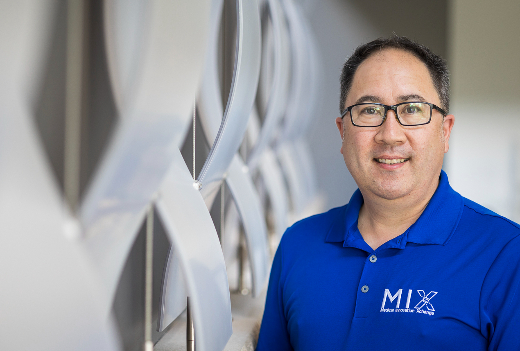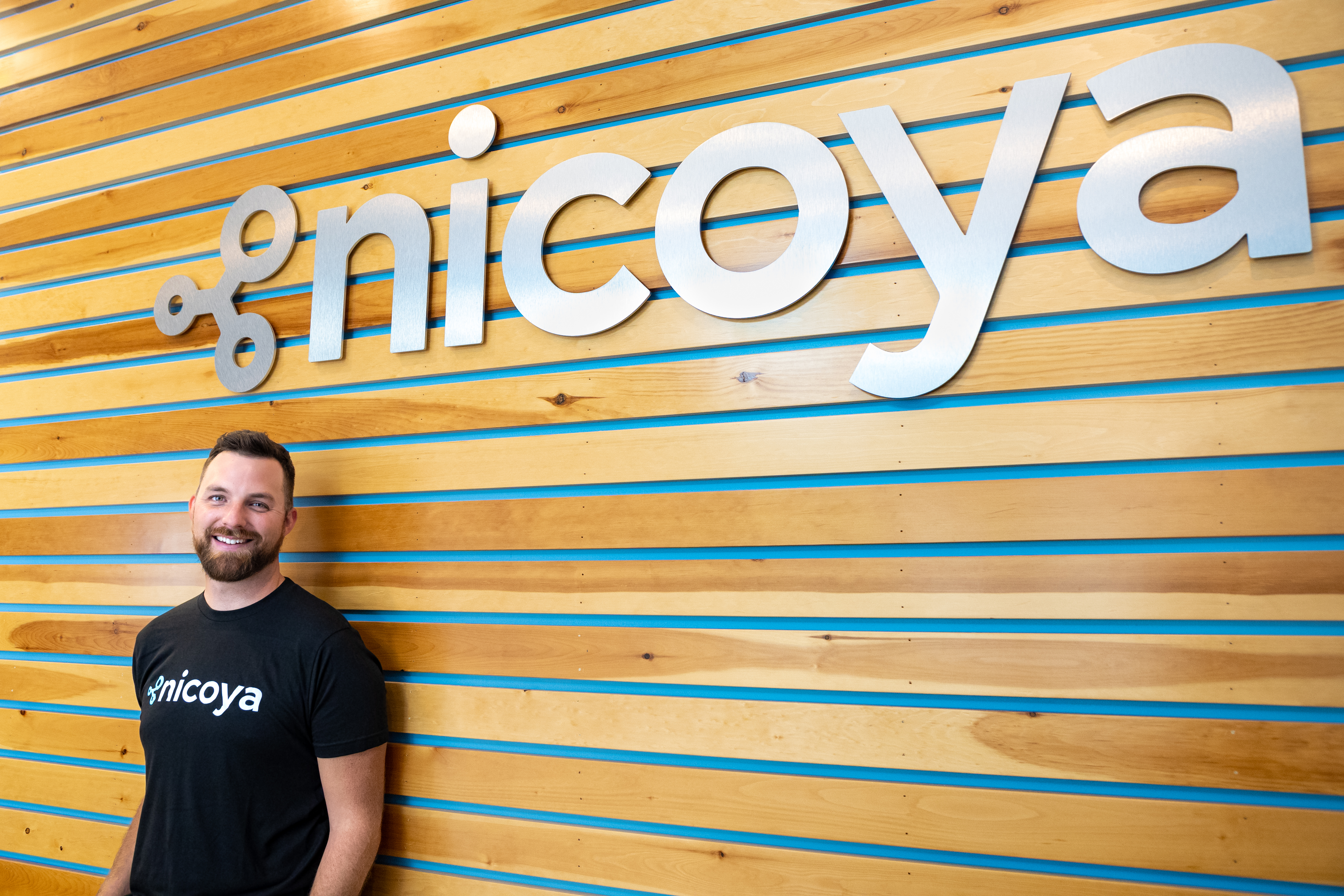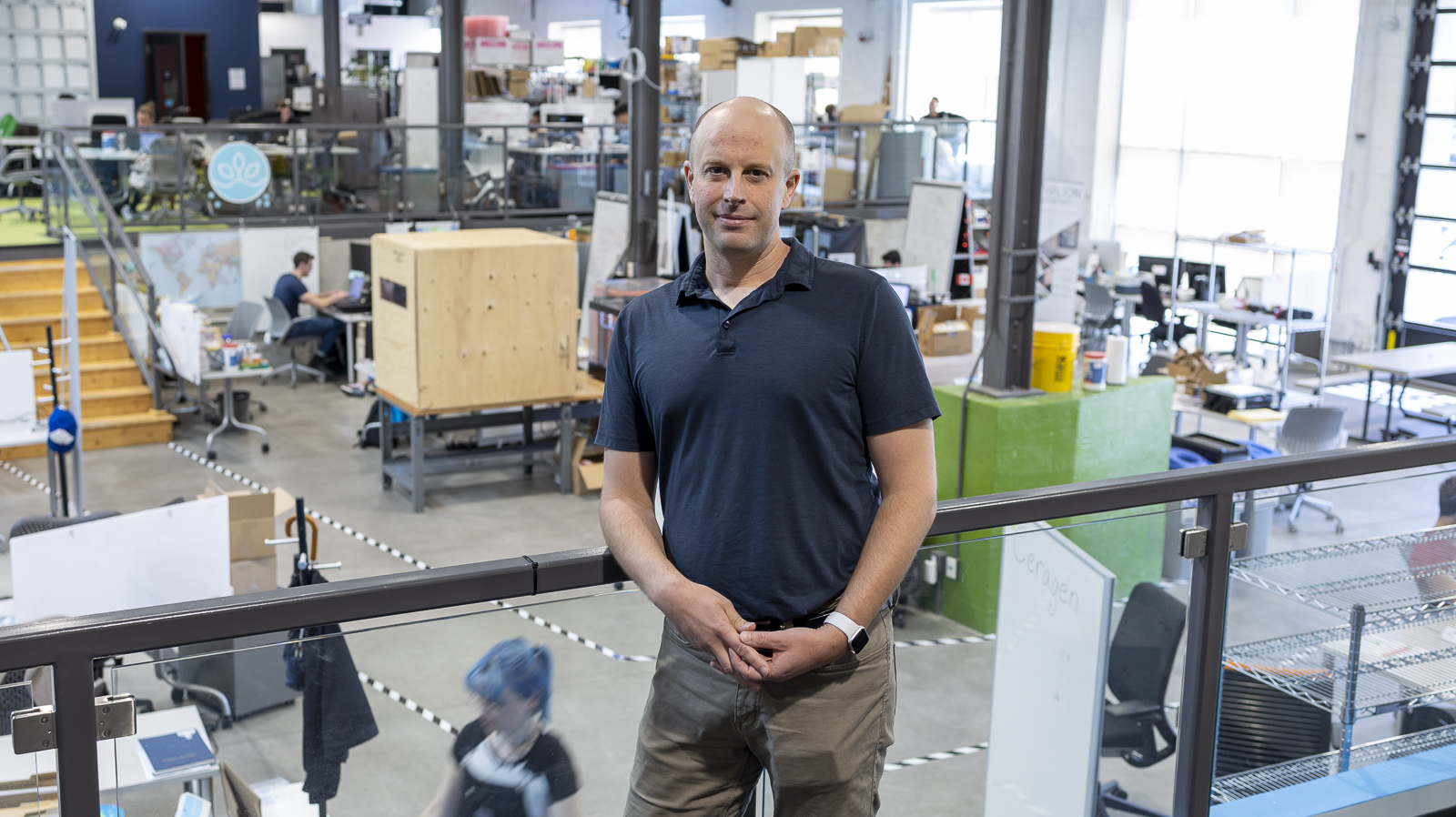When Armen Bakirtzian and two friends started Intellijoint Surgical in 2010, there were only a handful of other medical technology companies in Waterloo Region.
The three young engineers, who began developing surgical-navigation technology while they were still students at the University of Waterloo, received a lot of good advice about how to launch a startup.
What they couldn't find locally were mentors with significant experience in the specialized business of medtech.
“So we went out actively to the U.S. to find people who could help us get smarter,” recalls Bakirtzian, Intellijoint’s CEO. “Our goal was to ingest all of that knowledge and (bring it back to) KW and just keep growing our business, because it was our intention to stay in KW.”

Armen Bakirtzian, co-founder and CEO, Intellijoint (Photo courtesy Intellijoint)
Fast forward 12 years. There are now more than 100 health innovation companies based in Waterloo Region. There's also a growing ecosystem of expertise and support to nurture both early-stage and scaling health-tech ventures.
As a result, Waterloo Region is now home to companies that make a wide range of innovative medtech products, from blood-clot treatment technology to surgical navigation tools, post-operative monitoring systems, remote home-care and blood-testing platforms, life-science research tools, medical imaging and record-sharing software, a variety of AI and nanotechnology components for the makers of other medtech products, and more.
“There’s definitely way more support than there ever was, and I think that it’s all going in the right direction,” says Ryan Denomme, who founded Kitchener-based Nicoya Lifesciences in 2012 to help reduce the cost of scientific instruments and make them more accessible to researchers.
The medtech market
The strength of today's medtech sector in Waterloo Region owes a lot to a handful of forward-thinkers who see both an opportunity and a need to improve the way Canada fosters health innovation and makes it available to clinicians and patients.
The global market for heath technology is booming. In Canada, numerous advisory bodies and panels have concluded that we can improve patient care, reduce costs and fuel prosperity by, first, leveraging Canada's expertise in technology and life sciences, and second, changing the way we nurture and fund health-care innovation.
The numbers help explain why:
-
Total health-care spending in Canada was estimated at $308 billion in 2021, representing 12.7 per cent of the country's GDP.
-
Worldwide, health-care spending is fast approaching a combined US$10 trillion, amounting to 10 per cent of GDP for most developed countries.
-
There's an estimated 3,000-plus health-related tech companies in Canada. Ontario alone is home to more than 1,300 such companies, which together employ more than 26,000 people in skilled, well-paying jobs.
Consulting firm Deloitte sums up the medtech opportunity in its 2022 Global Health Care Outlook report:
“A collision of forces – a global pandemic of historic proportions; exponential advances in medical science; an explosion of digital technologies, data access, and analytics; informed and empowered consumers; and a movement from disease care to prevention and well-being – (is) proving to be the catalyst for the clinical, financial, and operational transformation that health care has long promised to the world.”
Closer to home, all levels of government have recognized the rich potential of Waterloo Region’s emerging medtech ecosystem.
A few examples:
-
A year ago, the federal government announced a $10-million investment to create a Southwestern Ontario health-tech innovation hub to commercialize technology, start companies and create jobs. Led by the University of Waterloo, the network includes Western University, the City of Kitchener, and the privately-run Medical Innovation Xchange, a co-location hub in Kitchener. Most of the federal grant - $6.5 million - was allocated to Velocity, UW's flagship entrepreneurship program.
-
Another regional support program is the Southern Ontario Pharmaceutical & Health Innovation Ecosystem (SOPHIE). Funded by FedDev Ontario, SOPHIE is operated by two Hamilton-based organizations - the Synapse Life Science Consortium and business accelerator, Innovation Factory. The program provides startups with up to $100,000 to access clinical and research expertise. Several Waterloo Region companies have benefited from SOPHIE, including NERv Technology, Hyivy Health and Tamvoes Health Inc.
-
The City of Kitchener has agreed to invest up to $8.5 million in UW's health-focused Innovation Arena, to be located in a repurposed warehouse at 280 Joseph St., which is part of the Health Science Campus that includes the UW School of Pharmacy in downtown Kitchener. Velocity will be the anchor tenant, sharing space with startup founders, researchers and health-care professionals, all focused on commercializing health innovations.
-
This year's federal budget included $30 million to assist Communitech and the Coordinated Accessible National Health Network (CAN Health) to accelerate the adoption of Canadian-made innovation through an "integrated markets" approach to health-care procurement.
-
The Ontario government is also encouraging publicly-funded agencies to buy Ontario-made products through its new Building Ontario Businesses Initiative (BOBI).
-
The Communitech-led Future of Health initiative brings tech leaders, researchers and public-sector officials together to collaborate on ways to improve Canadian health care through innovation. This relationship building also sets the stage for public agencies to procure more Canadian-made innovation.
-
In May, the Ontario government announced $1.6 million for a health-innovation skills training program launched by the Kitchener-based Medical Innovation Xchange (noted above).
The University of Waterloo is playing a key role in fueling the research, talent development and startup support upon which the region's burgeoning medtech industry is being built.
The university's 2020-25 strategic plan includes numerous references to health innovation - a reflection of the growing interest among researchers to collaborate across disciplines to solve health-care challenges. That interest - along with tangible projects like the Innovation Arena and leadership of the Southwestern Ontario health-tech network - represent a significant bet on the intersection between health and technology.
“There is a very strong desire to support this growing and high-potential sector in Waterloo Region and Southwest Ontario,” says Sandra Banks, UW’s Vice-President, University Relations.
Communitech CEO Chris Albinson agrees.
“As we recover from the pandemic, there has never been greater alignment for solving Canadian health challenges with Canadian innovation out of Waterloo Region,” he says.
Medtech in Waterloo Region
Waterloo Region has decades of experience launching startups and commercializing innovation. However, without the kind of health-tech focus that a research and teaching hospital often provides, the region lacked depth in medtech expertise, especially at the scaling stage.
That's not to say there were no health-tech companies early on. Unitron Industries began making hearing instruments in Kitchener in 1964. Northern Digital Inc. (NDI), one of the first spinoffs from UW, was launched in 1984 to make personal computers but soon pivoted to optical and tracking technology to assist surgeons. And Mitra Imaging Inc., founded in 1990 and sold to Agfa-Gevaert in 2002, made software for managing and sharing medical images.
Despite the success of such companies, it took years for a medtech ecosystem to take root in Waterloo Region.

Elliot Fung, Executive Director, Medical Innovation Xchange
(Communitech photo: Anthony Reinhart)
“The pathway to commercialization for medical technology and health innovation companies is quite different than traditional technology companies,” says Elliot Fung, Executive Director of the Medical Innovation Xchange (MIX). “Medtech companies that were at the scaling stage – hiring up to 20 people, looking at their QA (quality assurance) systems, and looking at certifications and Health Canada approvals, they needed a place to be able to go to get expert advice, and that just didn’t exist.”
MIX was launched in 2019 by Armen Bakirtzian and Intellijoint Surgical's VP Finance, Joshua Mitchell. Their goal was to create a co-location hub where established medtech companies can "pay it forward" by nurturing younger scaling enterprises with medtech-specific mentorship and advice.
“I’m of the mindset that we do a reasonably good job at starting medtech companies in KW, (but) we don’t do a very good job at retaining and scaling our companies,” says Bakirtzian, who served on the federal government’s Economic Roundtable on Health and Biosciences. “The future we want is a healthy ecosystem of domestic, commercial-stage medical-technology companies that were born here, that are being successful here, and that will survive here.”
Located next to Christie Digital on Wellington Street West in Kitchener, MIX recently expanded from 30,000 to 40,000 square feet of leased space. It is currently home to Intellijoint Surgical and four younger medtech companies: NERv Technology, Vena Medical, Emmetros and Bloom Care Solutions.
Another group working to strengthen the local ecosystem is Waterloo MedTech, which was founded in 2016 to “leverage the region’s unique collaboration innovation culture to address the gap between health-care research and its adoption in practice.”

Laurie Lafleur, a director with Waterloo MedTech
“Our focus with Waterloo MedTech is to try and bring the health-care providers and the innovators together,” says Laurie Lafleur, a director of the organization and a professor of health information sciences at Conestoga College, as well as a medtech growth coach at Communitech.
From 2016 to 2019, Waterloo MedTech held seminars and annual conferences to identify gaps, problems and solutions related to improving health care through technology and innovation.
Although these activities were interrupted by COVID-19, Waterloo MedTech is currently working with area doctors, hospitals, post-secondary institutions, tech founders and tech-support organizations to take stock of the health-innovation ecosystem in Waterloo Region and develop a strategy to strengthen it.
“We have a very rich and supportive ecosystem,” says Lafleur. “What we’re undertaking to do, really, is that, as an ecosystem, we agree these are our core strengths, this is where everybody in the ecosystem is sitting, this is where we overlap, and this is where challenges are. And from that, we hope to develop a set of recommendations.”
That ecosystem includes well-established organizations that have been providing support to area founders in a variety of tech industries for years.
“From my perspective, being able to have, early on, a really strong network of people through Communitech, the Accelerator Centre and Velocity – independent of what specific field I was in – I found that really helpful, just to understand the basics of starting a company,” says Nicoya’s Ryan Denomme.

Ryan Denomme, founder and CEO, Nicoya (Photo courtesy Nicoya)
Medtech challenges
Medtech founders face unique challenges that distinguish their journey from that of other tech companies. Two of the most significant are: first, strict regulatory standards; and second, a risk-averse health-care procurement system that's not structured to buy new, innovative products and services.
The regulatory side is understandable. For good reason, most countries require that diagnostic and therapeutic medical devices receive government regulatory approval to ensure safety and effectiveness. In Canada, the federal government has a four-tier classification system based on the risk associated with using the device. For example, a Class 1 device like a thermometer is deemed to carry less risk than a Class 4 device, such as a heart pacemaker.
It can take years to secure a medical-device licence. This validation process often involves extensive consultation with medical professionals, lab work, animal trials, clinical trials and manufacturing refinement. And time is money. Founders need investors with deep pockets - and an even deeper understanding of the medtech industry - to finance the long road to product approval and first revenues.
Take NERv Technology. The Kitchener-based scale-up has developed a highly promising patient-monitoring system that alerts medical staff to post-operative complications such as infections, fluid leaks and internal bleeding. After eight years of consulting, designing, building, testing and refining, NERv is close to announcing final regulatory approval from Health Canada.
“(We) went through two massive technical pivots, and these technical pivots were almost completely driven by the needs of the medical ecosystem,” says CEO and co-founder Youssef Helwa. “These changes happened by having ongoing conversations, and validation, and beta units, and test units being handed to surgeons and listening to their feedback.”
Another example is fellow MIX tenant Vena Medical. Founded by UW students in 2016, the company has developed a ground-breaking technology that helps doctors remove dangerous blood clots from a patient's veins. After six years of developing and refining its technology, Vena received Health Canada approval earlier this year. Its product, the Vena Balloon Distal Access Catheter, was used on a patient for the first time in June. Since then, it has been used on at least five patients at several Canadian hospitals, including the London Health Sciences Centre in London, Ont., The Ottawa Hospital and the University of Alberta Hospital.
Once a Canadian medtech company completes the regulatory marathon, it often runs into a second major hurdle: a risk-averse procurement system that makes it harder for Canadian medtech innovators to sell at home than abroad.
Generally speaking, cash-strapped Canadian hospitals only receive government funding to buy products and services that already exist on official reimbursement lists; there's little if any budget allocated to try innovative new technologies.
We're developing all of this great innovation and it can be very frustrating to go into a health-care organization and not see those innovations...”
– Laurie Lafleur, Waterloo MedTech
As a result, Canadian medtechs are often forced to look to international markets to make their first sales and establish their first revenue streams. Not only is this a challenge for fledgling Canadian businesses, it also means that Canadian clinicians and patients miss out on some of the best health-care products and services available.
“We’re developing all of this great innovation and it can be very frustrating to go into a health-care organization and not see those innovations – to know that they exist, to see them exist in other health-care organizations outside of our region, typically south of the border, and to not be able to benefit from it in our own health-care organizations,” says Lafleur.
The experience of Intellijoint Surgical is one of the best examples of this peculiarly Canadian problem.
Intellijoint's surgical-navigational technology, approved by Health Canada in 2015, is used in about 15,000 hip-replacement procedures internationally each year. Yet it wasn't until earlier this year that Intellijoint made its first sale to a Canadian hospital. And that customer, Toronto's Humber River Hospital, used one-off money from its foundation rather than from its operating budget to buy the Intellijoint product.
“The challenge is, disruptive innovation doesn’t have existing (government) reimbursements, and if you don’t have reimbursements, then it is impossible to get adopted and have your product paid for by any provincial system,” says Bakirtzian.
In March, the Ontario government gave Kitchener's Grand River Hospital $1 million to run a trial study involving Intellijoint's hip-surgery technology. The one-time grant was welcome news but not a long-term solution to the fundamental problem.
“The only way that our products are going to get adopted in a meaningful way is by removing the barrier of lack of reimbursement,” says Bakirtzian. “In my view, that’s the solution that all of us need – a pathway to gain reimbursement.”
Elliot Fung, a former VP of Innovation and Strategic Partnerships at Ontario Health who now serves as the Executive Director of the Medical Innovation Xchange, says there's no lack of innovative medical technology in Canada, just an inability to procure it.
“What we really need, in Ontario especially, is innovation budgets in our health system, where health-system providers are empowered with an innovation budget to go out and procure and test out and first-project those ideas,” he says.
Lafleur agrees.
As a professor of health information sciences and a director of Waterloo MedTech, Lafleur has looked at how other countries fund health-care innovation.
The situation in the U.S., with its emphasis on private health care, is quite different than the Canadian system, where we rely almost exclusively on publicly funded hospitals and health services.
“The United States looks at (health care) innovation as a differentiator and a core business driver,” says Lafleur. “If they do not innovate, they will not attract the big payers and they will not get the big numbers of patients, and their (health-care) businesses will not survive, just like any other business.”
Yet some countries that have publicly-funded health-care systems - Australia and the U.K., for instance - have found ways to fund home-grown innovation.
“I think the government of Australia has actually done a really good job,” says Lafleur. “Not only do they support those innovative procurement models, but they also include ‘set asides’ for small- to medium-size enterprises. So there’s actually incentives or requirements for health-care organizations to purchase at least some solutions from smaller organizations. We don’t have that here in Canada.”
Fung says provincial health budgeting models need to incentivize positive outcomes rather than sticking to a rigid system that only pays for technologies that already have a billing code.
“If we shifted in Canada to be able to compensate and reward health systems for outcomes, then you would see a lot more uptake of some of these Canadian medical technologies that are improving outcomes and making life easier for patients and clinicians,” he says.
Funding health-care innovation is at the heart of the partnership between CAN Health and Communitech. The two organizations are working to extend an “integrated markets” procurement network across Canada. This approach removes some of the risk aversion that often shapes health-care purchasing decisions by allowing new, innovative technologies to be tested and verified by one member of the network so that all members can purchase the product with confidence.
“Together with Communitech, we are focused on connecting made-in-Canada innovative solutions to the real-world issues facing our nation’s health care system,” Dr. Dante Morra, Chair of CAN Health, said in April when Ottawa awarded $30 million for expansion of the agency’s procurement networks.
Regional partnerships
Although there's been talk about building a teaching and research hospital in Waterloo Region, partnerships already exist with the health-science expertise and lab services associated with McMaster University in Hamilton and Western University in London, both just an hour away.
A number of Waterloo Region medtechs make use of medical expertise, lab facilities and related services located across Southern Ontario.
The founders of Intellijoint, who wanted to keep their company based in Waterloo Region, worked with surgeons in several communities to help develop and improve their hip-surgery navigational product.“We had 12 surgeons (help) design our product,” says Bakirtzian. “They came from London, Hamilton, Toronto and Waterloo. I’ve been beating that drum for a decade: we don’t need to be in Toronto, we don’t need to be in Hamilton, we don’t need to be in London – we’re an hour away from all of them. How much closer do you need to be?”
We've got a lot of very collaborative, positive, forward-looking individuals across the two communities who are making the trips down Highway 6 and who are developing those relationships.”
– Alex Muggah, Synapse Life Science Consortium
NERv Technology is another example. The Kitchener-based scale-up has had a number of collaborations with health-science resources in Hamilton. In 2019, NERv placed second in the Synapse Pitch Competition, earning it $10,000 in cash, plus $5,000 in in-kind services and a three-month mentoring program. Earlier this year, the Hamilton-based Synapse Life Science Consortium helped fund a NERv clinical trial involving Hamilton Health Sciences and the University Health Network.
“We’ve got a lot of very collaborative, positive, forward-looking individuals across the two communities who are making the trips down Highway 6 and who are developing those relationships,” says Synapse Director Alex Muggah, who collaborates regularly with colleagues at Communitech, Velocity and the Medical Innovation Xchange.
Hamilton's renowned expertise in health research and clinical trials is an excellent match with Waterloo Region's tech creation, entrepreneurship and commercialization experience, he says.
“What’s really nice about Hamilton-KW is that they are complementary communities, which is good because neither one is even a fraction of the size of a Toronto or a Montreal or Vancouver,” says Muggah.
The other regional partnership that's taking shape is the Southwestern Ontario health-tech innovation hub, which is being led by UW with a $10 million investment from FedDev Ontario.
“Because of the support we've had from the federal government, we were able to bring in additional partners like MIX and like Western University, which has a preeminent medical school and a medical innovation program,” says Sandra Banks, UW’s Vice-President, University Relations. “They were very keen to collaborate and be part of this, which not just extends the geography but extends the capacity and the access to what Western University has in its toolkit that Waterloo doesn't.”
Medtech founders
Why would a young entrepreneur choose medtech, given the costs, hurdles and length of time it takes to build a health-innovation company?
Many medtech founders have a personal connection to health care and a passion to make a positive impact on people's lives.
Salutech CEO Shuhe Li found inspiration close to home.
After earning an MBA and a law degree, Li began working with her father - a cardiovascular scientist - to commercialize a biomaterial he developed to mitigate the erratic electrical activity behind irregular heartbeats.

Shuhe Li, CEO, Salutech
“If I succeed, it’s not about me exiting or being this super-successful person,” says Li. “It’s actually knowing that I could make people’s lives so much better.”
NERv co-founder Youssef Helwa has a similar story.
His mother, a surgeon, would often talk about her work experiences. Those stories impressed Helwa, who, as an aspiring engineer, began to think that one day he could use technology to make peoples' lives a little bit better.
Years later, he co-founded NERv while earning an undergraduate degree in nanotechnology and a master's in electrical engineering at the University of Waterloo.
“Just knowing that there is an opportunity to create solutions that could change the life of one person is really motivating,” says Helwa. “And an engineer serving doctors can potentially impact the lives of millions of people. That’s amazing – that’s really incredible.”
Armen Bakirtzian also found inspiration at home.
While searching for a capstone project for his engineering program at the University of Waterloo, Bakirtzian asked his father, an orthopedic surgeon, if there was anything that would improve patient outcomes. His father said one of the biggest challenges during hip-replacement surgery is orienting the artificial hip as precisely as possible. From that conversation, Bakirtzian and two classmates began developing what is now Intellijoint's flagship product, the Intellijoint HIP, which provides surgeons with intraoperative measurements to ensure the proper positioning of orthopedic implants during joint replacements.
“You kind of get conditioned towards health care through your childhood,” Bakirtzian says of his interest in medtech. “It was a combination that this is a real problem to solve and that it benefits people.”
Adrien Côté, Executive Director of UW's renowned Velocity program, says he's seeing more students interested in healthtech because they want to make a difference in the world.

Adrien Côté, Executive Director of Velocity (Communitech photo: Anthony Reinhart)
“We work with 2,400 students every year and we're seeing a real shift (where) many of these students are aspiring to build a company because they want to create a change, and many of the changes they want to create in the world relate to human health,” he says.
Looking forward
So what's the current state of medtech in Waterloo Region?
The ecosystem does a good job of nurturing startups observers say but there is still work to be done locally to support medtech scale-ups. And looking Canada-wide there is still a pressing need to overcome innovation procurement barriers.
“We have a clear understanding of the challenge, which is lack of reimbursement, and I think there’s also an acknowledgement from the province to say, ‘Hey, we can do this better,’” says Bakirtzian. “And that’s the avenue that our innovators need the province to improve on in order to unlock the home market for our home innovators.”
Laurie Lafleur says another challenge is getting health innovations that are being created right here in Waterloo Region into the hands of clinicians to improve patient care.
“We have such a strong ecosystem,” she says. “We have a lot of people that are rallying around to support it. I think once we crack that nut in terms of how we diffuse more of it locally, it’s going to be for the benefit of everybody.”
The last word goes to Elliot Fung Executive Director of the Medical Innovation Xchange in Kitchener:
“Our vision is when people think about medtech across the world, they think of Austin, they think of Boston, they think of Waterloo Region,” says Fung. “We want to create an internationally recognized hub for medtech here. We strongly believe that is attainable. The pandemic has proved that medtech is a very stable industry – it will always be needed – and we’ve got pretty much everything we need in this region to be able to build and grow these companies.”

